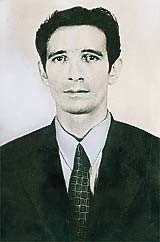Carlos Lamarca facts for kids
Carlos Lamarca (born October 23, 1937 – died September 17, 1971) was a Brazilian Army Captain. He left the army to join groups that resisted the military government in Brazil. He became a key leader in the Popular Revolutionary Vanguard (VPR). Along with Carlos Marighella, he was one of the main figures in the fight against the military dictatorship. These groups often used armed actions to protect themselves from a government that treated people harshly if they disagreed.
Contents
Early Life and Joining the Resistance
Carlos Lamarca was born in Rio de Janeiro on October 23, 1937. In 1955, he started his military training at a special school in Porto Alegre. Two years later, he moved to the Military Academy of Agulhas Negras. He graduated from there in 1960.
Lamarca served with the United Nations peacekeeping forces in Gaza during the Suez War. After returning to Brazil, he supported the military takeover in 1964. In 1967, he was promoted to Captain. In 1969, he left the Army to join the VPR. He took a truck full of military equipment with him to help the resistance movement. This action was planned with Sergeant Darcy Rodrigues and others.
Life as a Resistance Leader
Lamarca became a very active member of the groups opposing the 1964 military government. He took part in several operations, including actions to get money for the resistance. He also helped set up a training camp in the southern part of São Paulo state.
In 1970, the Army found this camp. Lamarca was involved in a serious incident where a military police officer, Alberto Mendes Júnior, was killed. The officer had surrendered to protect his injured fellow soldiers. Later that year, Lamarca led the kidnap of the Swiss Ambassador, Giovanni Enrico Bucher. The goal was to exchange him for political prisoners held in Rio de Janeiro. During this event, a Federal Police Agent, Hélio Carvalho de Araújo, who was protecting the Ambassador, was killed.
Lamarca later left the VPR and joined a new group called the Revolutionary Movement 8th October. This group sent him to Bahia to help start a movement in the countryside. On September 17, 1971, the Army found him in a small town called Pintada (now Ipupiara). He was killed while resisting arrest, along with another VPR member, José Campos Barreto.
Personal Life
Carlos Lamarca was married to Maria Pavan, who was his foster sister. They had two children together. His wife had to leave Brazil and live in Cuba because of the dangers she faced. Lamarca also had a close relationship with Yara Yavelberg, who was also involved in the resistance against the dictatorship.
Yara Yavelberg died two days before Lamarca. Her death happened under unclear circumstances in an apartment in Salvador, the capital of Bahia.
Remembering Carlos Lamarca
Years after his death, Lamarca's family worked hard to get official recognition and payment for his death from the government. His wife and children received money as compensation for the time they lived away from Brazil in Cuba. His widow also receives a regular payment, similar to a general's salary, according to a special law passed in 1979.
The city of Ipupiara built a public square where Lamarca died. This square, called Praça Capitão Carlos Lamarca (Captain Carlos Lamarca Public Square), has a playground, a fountain, and a statue of him. It was opened on January 13, 2007. The city also made September 17, the day he died, a local holiday to honor him.
Images for kids



